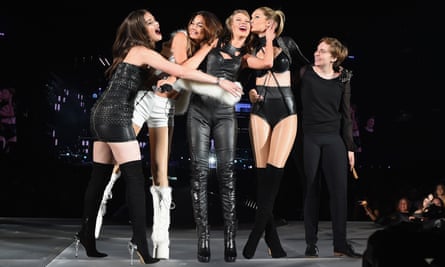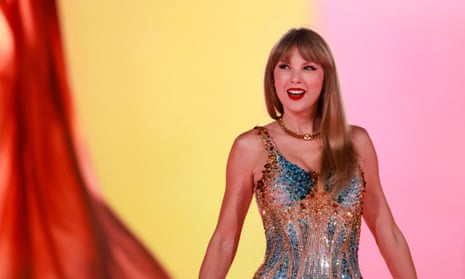Last month, Taylor Swift wrapped up the first leg of the Eras tour – a career-spanning, three-hours-plus stadium spectacular that’s proved to be the year’s single most significant pop culture phenomenon, Barbenheimer be damned.
Eras has generated an estimated $5bn boost to consumer spending in the US, forcing cities to ramp up underprepared public transport systems and world leaders to turn into reply guys: Justin Trudeau pleaded with her on Twitter to come to Canada. And fair enough: I saw the final US Eras show in August and found it to be one of the most euphoric concerts I’ve ever seen, a reminder of Swift’s singular generational talent.
When Eras concludes in November 2024 it is likely to be the highest-grossing tour of all time with an estimated $1.4bn in revenue – half a billion more than Elton John’s farewell tour, the current record holder. Even a filmed version of Eras being released in US cinemas in October brought in $37m the day that tickets went on sale. All told, the tour has re-established Swift as the most successful pop star in the world, after a few years in which a resurgence seemed far from likely.
By the time the South American leg commences in November, Swift will have released her third album in 12 months, the re-recorded version of 1989. It’s the album that, on its original release in 2014, made her as omnipresent as Michael Jackson and Madonna had been in the 80s. Newspapers and blogs obsessed about “the squad” – the revolving clique of models, actors and musicians that surrounded her. But by the end of the attendant world tour she was being accused of self-serving and superficial “girl boss” feminism and there were public squabbles with Kim Kardashian, Kanye West, Katy Perry, Nicki Minaj and Calvin Harris. A fierce backlash was soon under way.

But next month, when Swift releases 1989 (Taylor’s Version), it’s possible that it may debut with higher first-week sales than the album it’s recreating; her current cultural dominance makes the original 1989 era look small scale. How has Swift managed to restore her stature without succumbing to the pitfalls that felled her last time?
In the immediate aftermath of the 1989 fallout, Swift broke her pattern of releasing a new album every two years, instead waiting three to return in 2017 with Reputation, billed as her retort to the haters. Louis Mandelbaum, host of the pop music podcast Pop Pantheon, says that Reputation is “actually more interesting than that: it’s really about her finding refuge in a new relationship in the face of [being] ostracised”, but its presentation – she wiped her once effusive social media accounts and adopted gothic imagery – allowed Swift to play with her newly tarnished image. “She attempted to parlay the negative press about her into the narrative of the record; like, ‘I’m taking ownership over how you view me,’” he says.
Many fans now feel Reputation is underrated, but “relative to 1989, it was less [commercially] successful. And she was so intent on responding to the backlash that she obscured what the album actually was.” In 2019, Swift released her seventh album, Lover, a record that literally wore its heart on its sleeve to affirm that she had moved on from the drama and was happy. It was one of her least successful records, her first since 2010’s Speak Now’s to not produce any US No 1 singles.
Its release did, however, coincide with another feud: the original masters of her first six albums were acquired by manager Scooter Braun and then resold without Swift’s approval. She announced that she would release note-for-note re-recordings of the albums in order to devalue the Braun-owned versions.
Mandelbaum says that Swift’s feud with Braun “allowed her to gain a certain amount of empathy from the public that she had lost at the peak of her post-1989 era. It was easy for most pop fans to say: this male music executive is attempting to steal the art of this female singer-songwriter. It then allowed her to put the focus back on her songwriting: ‘I should own my songs because I wrote them in my bedroom when I was 15 years old.’”
The pandemic provided another boost: in 2020, Swift surprise-released Folklore and Evermore, two albums produced with the National’s Aaron Dessner that repositioned her as a serious musician, not just a pop star. Maltese-British singer-songwriter Lauren Aquilina, a Swift devotee who supported her on her 1989 tour, cites Folklore as her favourite of Swift’s albums, calling it “so well rounded and sure of itself” and the work of “somebody who has absolutely mastered their craft”. The lyrical focus turned outwards again, giving new fans “an opportunity to appreciate her storytelling”.

Swift started releasing the Taylor’s Version re-recordings in spring 2021 andput out another original album, Midnights, in 2022. That record “brought some of those more folky storytelling elements into the pop stuff, and blended them naturally,” Aquilina explains, saying that songwriting-wise, Swift has now “proved she can do whatever she wants to do”. She hasn’t left the charts since, breaking records for having the most albums in the US Top 100 and becoming the first act since the Beatles to have songs from three different albums in the US singles chart.
Crisis publicist Lauren Beeching says that beyond the musical talent it’s Swift’s ability to recast her image that’s given her such longevity. “She is a snake in the most positive way,” she says, referring to an insult hurled at and then reclaimed by Swift during the Reputation era. “She sheds her skin and becomes a new version of herself to fit in with today’s culture. You never know what will come next, which is what keeps her fans so engaged.”
Now Swift is more famous than ever, fans and critics are wondering if another backlash is brewing. The Eras tour has become a huge story, not just for Swift’s performance but for its unprecedented cultural and political impact – Ticketmaster’s mishandling of the Eras tour rollout, criticised by Swift, has led to an antitrust investigation – while moments from the show constantly go viral online.
Swift has seemingly put up the “squad” bat signal, being spotted with Gigi Hadid, the Haim sisters and Blake Lively, and her dating life is back in the news: in January, she broke up with Joe Alwyn, her partner of six years, and was soon linked to Matty Healy, firebrand frontman of the 1975. Healy got in hot water for laughing along with racist jokes on a podcast, leading extreme Swifties to petition her to break up with him. Some fans have also expressed disquiet at the endless stream of special-edition merchandise that Swift puts on sale – the same record in various vinyl colourways, endless associated apparel – feeling gouged by what some are calling her “capitalist era”.
But the nature of fame has changed since Swift’s last fall from grace, and in her favour. When Swift released 1989, there was no way to be a megastar pop icon without blanket media coverage, meaning that there was a vast audience forced to interact with Swift content who didn’t actually want to see it. Beeching says that, at that point in time, Swift “was so analysed – the poor girl couldn’t even go on a date without receiving a ludicrous amount of hate”.
Today there is less of a monoculture, and conversation is chiefly driven by users of TikTok, Reddit and X. The fandoms that have emerged on those social media platforms are siloed and diffuse; the algorithms that serve users content are prone to showing them things they are already predisposed to like. This ecosystem has spawned celebrities such as the video game-esque vlogger Pinkydoll, dancer turned pop star Addison Rae and riot-causing Twitch streamer Kai Cenat – hugely famous to those who are interested, largely unknown to those who are not.
“We’re in the era of everyone being a cult star, from Taylor, down to Charli XCX,” says Mandelbaum. “There is less imperative for pop stars to create music that’s all-encompassing; all Taylor has to do is play into what her fans want from her.” Swift can be the most famous person in the world to those who love her, while remaining out of the feeds of those who don’t.
In her second go at pop’s peak, Swift is therefore more insulated against the forces that precipitated her downfall last time, while her songs remain heavily played on still-important legacy platforms such as pop radio. And Eras has its own promotional power: the Lover album track Cruel Summer has exploded in popularity off the back of the tour, leading Swift to push it as a single. The re-recording project means she has gone from one album every two years to two or three a year, along with deluxe editions, meaning there’s a constant drip feed of new music being uploaded to streaming services. Swift had four albums in the US Top 10 at once this summer, matching a record set by Herb Alpert in 1966.
For aspiring stars, pop’s new economy has proved challenging. Last month, a Billboard report detailed the music industry’s struggle to mint new A-listers – managers and industry executives bemoaned the fact that the last big pop star to break was Olivia Rodrigo in 2021; one lamented that “people are just buried in content”. Younger stars such as Sabrina Carpenter and Afrobeats singer Rema may be netting significant streaming hits, but it takes a far bigger push than it used to for a star to break through to Swift level, simply because even if your feed is flooded with videos of Carpenter, it is likely that the person sitting next to you on the train is only seeing clips of Rema.
For Swift, this is a boon. There’s just too much content online for any one person to become significantly overexposed and fewer avenues for fans or haters to air grievances that will be seen by broad swaths of the population. It’s also the reason why Healy, who has faced his fair share of controversies, has proven remarkably weatherproof, and the attempted cancellation-by-association of Swift went nowhere.
As Mandelbaum says, Swift’s prime mode these days is fan-service. “Even people that don’t like her begrudgingly admit that she has achieved so much through her own merits and talent and vision,” he says. But they’re not the point. “She is only in communication with the people that love her, and doesn’t need to care about the people who don’t – because there are just so many people that love her.”
